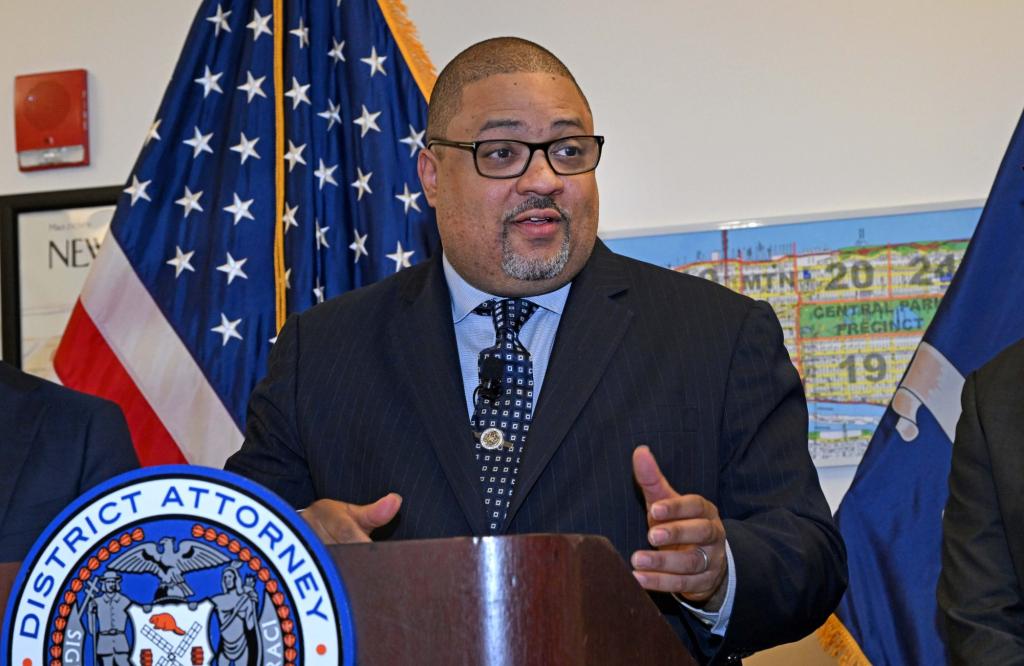Alvin Bragg can help end protest violence — by throwing the book at the perps


Manhattan District Attorney Alvin Bragg has never been shy about being an activist prosecutor who uses the discretion his office affords him to decide what behavior Manhattan will put up with and what behavior it won’t.
So it’s up to Bragg whether the Columbia University lawbreakers who escalated their “protests” to violence will face consequences — or whether we can expect more such behavior as it goes unpunished.
The allegations emerging from the Columbia chaos of two weeks ago are disturbing.
As Hamilton Hall custodian Mario Torres told The Post, a masked mob armed with tools for violence — hammer, rope, duct tape, zip ties — invaded the building in the middle of the night of April 30 and prevented him and two colleagues from leaving.
“We had to fight our way out,” he says.
In another account, one invader tried to give Torres “a fistful of cash.”
Torres showed physical evidence that as he tried to leave, he had been “assaulted and battered.”
A co-worker, Lester Wilson, said he had been “held against [his] will.”
What kind of alleged crimes are these?
The answer, as we know from activist prosecution — a practice that pre-dates Bragg — is that they’re whatever crimes Bragg wants them to be.
In one scenario, the alleged perpetrators, including career anarchist James Carlson, plea-bargain, say, a felony burglary charge down to, say, misdemeanor trespass, and avoid prison, and even a permanent criminal record, with good behavior.
Or: Bragg could boil the suspects in a stew of felony and misdemeanor charges, and pressure them with jail time.
Yes, his Trump case proves that when Bragg wants to, he can throw the book.
But you don’t need that one-off case to grasp the point.
Remember Miya Ponsetto?
In 2020, the 23-year-old woman grabbed and shoved a teenager whom she had falsely accused of stealing her phone in a Manhattan hotel.
An altercation instigated by an impulsive jerk — but one that resulted in no injury.
In a sane world, this everyday altercation would not have taken up one minute of the criminal-justice system’s time.
Yet Bragg’s predecessor, Cy Vance, charged Ponsetto with two felony unlawful imprisonment charges, adding hate crime allegations (the victim was black, the perpetrator Hispanic and Asian).
Vance also added in two counts of misdemeanor aggravated harassment and child endangerment.
Bragg inherited the case in 2022, and forced Ponsetto to accept a plea of one felony unlawful imprisonment counted as a hate crime.
Remember Amy Cooper? She called 911 and gave a factual description of the man who, by his own admission, had randomly accosted and intimidated her in Central Park, also in 2020.
Bragg’s predecessor, Cy Vance, threatened her with jail — even though all he could come up with was a misdemeanor false-report charge — until she underwent racial-bias training.
(Cooper was white; her supposed victim, who instigated the confrontation, was black.)
Remember Adam Tang? A decade ago, Vance charged him with reckless endangerment and reckless driving for taking a video selfie speeding around Manhattan in his BMW.
Vance threatened jail, and Tang, not a US citizen, fled the country. Convicted in absentia, he lost his expensive vehicle to seizure.
All of these cases have something in common: In normal times under normal circumstances, none of them would have become a criminal case.
Vance wanted to make a point, in the new Vision Zero traffic-calming era, that speeding was a potentially deadly crime — and so he made an example of Tang.
He wanted to make a point about white women accusing black men, so he made an example of Amy Cooper.
Bragg sought to make a similar example of Ponsetto, calling her “racial profiling” an instance of “outrageous behavior.”
Does Bragg find the Columbia invaders’ behavior “outrageous”?
If so, there’s a multitude of charges he can pursue.
There is felony “unlawful imprisonment in the first degree” — breaking the law to “restrain another person.”
There’s assault.
There’s felony burglary involving injury.
There are lower-level crimes, including “criminal solicitation,” asking someone else to help you commit a felony — what Torres alleges these mobsters did when they tried to hand him cash.
There’s “conspiracy,” planning a felony with other people. There’s “possession of burglar’s tools.”
These are serious crimes, with a burglary felony rating a years-long prison sentence.
And unlike the Ponsetto and Cooper cases, these were planned, or foreseeable,crimes. The people who broke into Hamilton Hall knew that workers might be inside.
Was breaking into Hamilton Hall a crime that carried human collateral damage, or a victimless protest?
It’s Bragg who has discretion to decide — and determine what kind of city we live in.
Nicole Gelinas is a contributing editor to the Manhattan Institute’s City Journal.







